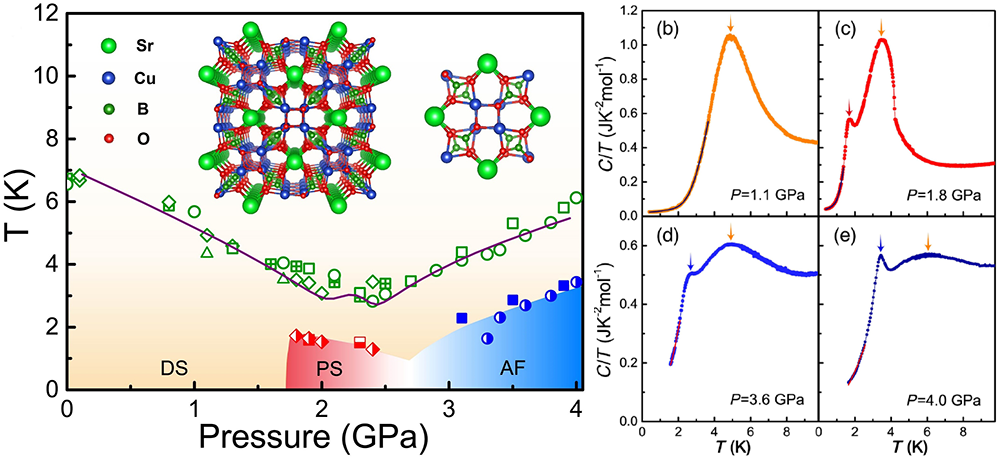Quantum Phases of SrCu2(BO3)2 from High-Pressure Thermodynamics
Date:01-06-2020 Print
In recent years, theoretical proposals for exotic states in quantum magnets are developing very rapidly, but many of these intriguing quantum phases and transitions have been difficult to realize experimentally. One class of such states is the valence bond solid, in which spins entangle locally and form symmetry-breaking singlet patterns. Signatures of a state with four-spin singlets were recently detected in the two-dimensional (2D) quantum magnet SrCu2(BO3)2 under high pressure. This plaquette singlet (PS) state has remained controversial, however, and a putative phase transition into an antiferromagnet (AF) at still higher pressure has not been studied. In 2018, under the suggestion of Prof. Anders W, Sandvik from Boston University and Prof. Ziyang Meng from Institute of Physics (IOP), Chinese Academy of Sciences, an international team led by Prof. Anders W, Sandvik, Profs. Liling Sun, Ziyang Meng, Shiliang Li from Institute of Physics (IOP), Chinese Academy of Sciences, were established and started a comprehensive investigation of the frustrated magnet material SrCu2(BO3)2 with the goal of mapping out the quantum phases at lower temperatures and higher pressures than previous reached.
Prof. Liling Sun, Associate Prof. Jing Guo et al, in collaboration with Prof. Vladimir A Sidorov from the Institute for High Pressure Physics of the Russian Academy of Sciences, systematically performed high-pressure heat capacity measurements on the high quality single crystals that were grown by Prof. Shiliang Li and Ph.D. student Hongshan Wen. They found that the material maintains its paramagnetic quantum dimer state (DS) below 1.8 GPa and then undergoes a first-order quantum phase transition from the DS to a phase with signatures of a plaquette-singlet state (PS) at ~ 1.7 GPa below T=2 K. The PS state prevails up to 2.4 GPa. Upon further increasing the pressure, a transition into a previously unknown antiferromagnetic state below 4 K was observed.

Fig. 1 (a) Phase diagram of SrCu2(BO3)2 (crystal structure in the inset) from high pressure C(T) measurements. Examples of C(T)/T curves are given in (b)–(e), where the orange arrows indicate the hump location.
Profs. Anders W Sandvik and Ziyang Meng, Ph.D student Guangyu Sun and Postdoc Nvsen Ma, in collaboration with Bowen Zhao from Boston University and Prof. Ling Wang from Beijing Computational Science Research Center, performed theoretical calculations on the high pressure behaviors of SrCu2(BO3)2. They designed a checkerboard J-Q model on both 2D and 3D lattices and employed quantum Monte Carlo simulation to compute the thermodynamic signals of the model, with the goal of studying universal physics of the PS and AF phases. As shown in Fig.2 (b) and (c), they computed the heat capacity of the 2D and 3D model. Their results for the 3D system are qualitatively consistent with the experimental findings of the corresponding phases in the Fig.1.

Fig. 2. (a) In the checkerboard J-Q (CBJQ) model. (b) The phase diagram of 2D CBJQ model. The PS-AF quantum-critical point is at gc ≈ 0.179 and there is AF order only at T =0. The inset shows C/T at g < gc. The hump-peak separation increases and the area under the peak decreases as g → gc. (c) The Phase diagram of 3D CBJQ model. The PS-AF phase transition happens at finite temperature, and the insets show the heat capacity as a function of temperature in PS and AF phases, the results are consistent with the experimental observations.
The findings obtained by this team provide the first complete phase diagram of this important paradigmatic frustrated magnetic material, which can be quantitatively explained within the famous two-dimensional Shastry-Sutherland quantum spin model supplemented by weak interlayer couplings. The possibility to tune SrCu2(BO3)2 between the plaquette-singlet and antiferromagnetic states opens opportunities for experimental tests of quantum field theories and lattice models involving fractionalized excitations, emergent symmetries, and gauge fluctuations. These results have been published on Physical Review Letters (https://journals.aps.org/prl/pdf/10.1103/PhysRevLett.124.206602).
The study was supported by the National Science Foundation, the Ministry of Science and Technology of China, the Chinese Academy of Sciences, as well as grants from the US.
Contact:
Institute of Physics
Liling Sun
Email:llsun@iphy.ac.cn
Boston University
Anders Sandvik
Email:sandvik@buphy.bu.edu
Key wards:
Frustrated material; quantum phase transition; High pressure
Abstract:
We report heat capacity measurements of SrCu2(BO3)2 under high pressure along with simulations of relevant quantum spin models and map out the (P-T) phase diagram of the material. We find a first-order quantum phase transition between the low-pressure quantum dimer paramagnet and a phase with signatures of a plaquette-singlet state below T =2 K. At higher pressures, we observe a transition into a previously unknown antiferromagnetic state below 4 K. Our findings can be explained within the two-dimensional Shastry-Sutherland quantum spin model supplemented by weak interlayer couplings. The possibility to tune SrCu2(BO3)2 between the plaquette-singlet and antiferromagnetic states opens opportunities for experimental tests of quantum field theories and lattice models involving fractionalized excitations, emergent symmetries, and gauge fluctuations.


